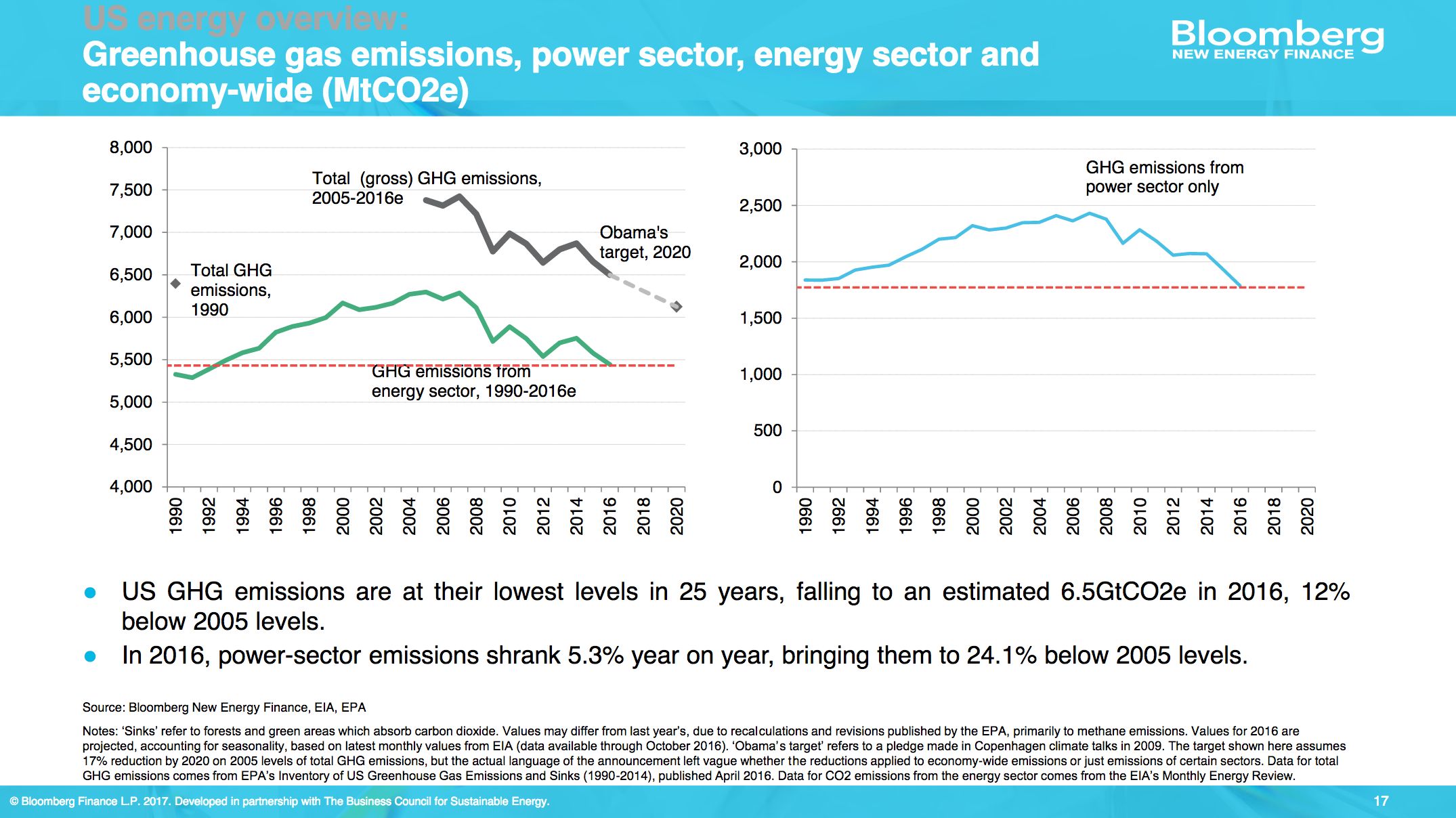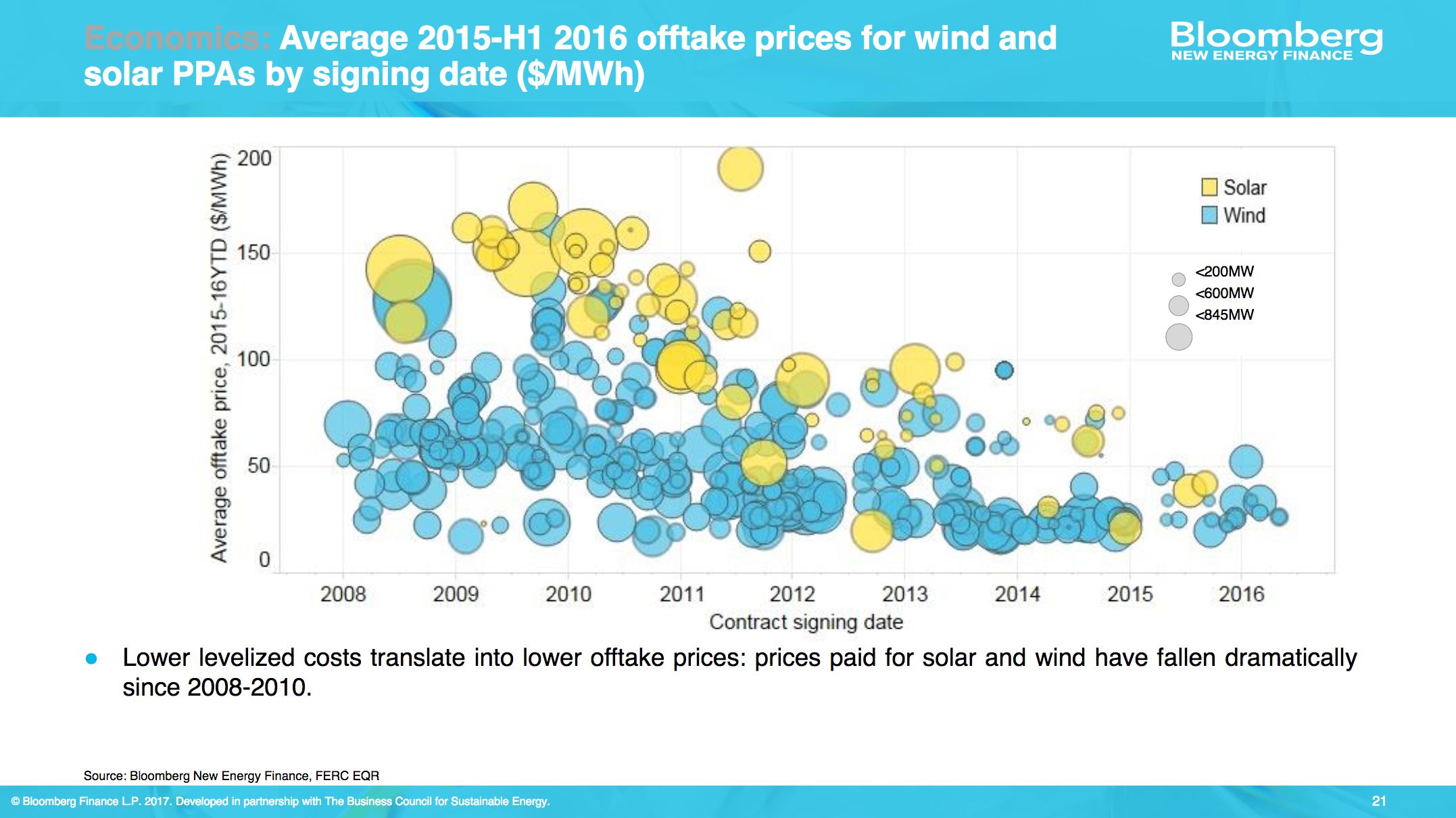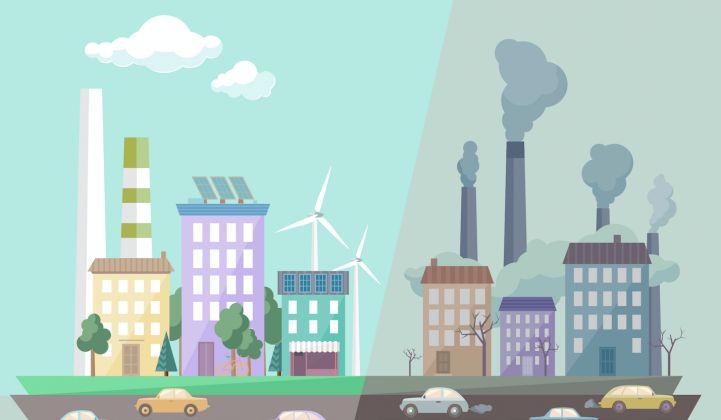After decades of technology development, business model innovation and policy progress, the U.S. economy is now decisively growing -- independent of energy consumption and carbon emissions.
Since 2007, U.S. GDP has grown by 12 percent, while energy consumption has fallen by 3.6 percent, according to the new 2017 Sustainable Energy in America Factbook, compiled by Bloomberg New Energy Finance (BNEF) for the Business Council for Sustainable Energy (BCSE).
This year’s fifth edition report builds on last year’s Factbook findings that show the U.S. economy grew by 10 percent since 2007, while energy consumption fell by 2.4 percent. “In other words, energy productivity continues to improve as less and less energy is needed to fuel growth,” the authors wrote.
At the same time, greenhouse gas emissions are plummeting. Total U.S. greenhouse gas emissions hit a 25-year low in 2016, down 12 percent from their peak in 2007 and 11.6 percent below 2005 levels. That puts the U.S. nearly halfway toward its Paris Agreement pledge to reduce national emissions by 26 percent to 28 percent below 2005 levels by 2025.
Reductions are even more notable within the power sector, which saw greenhouse gas emissions fall by 5.3 percent in 2016 alone. The power sector’s carbon footprint has shrunk by 24 percent since 2005, thanks in large part to market forces that increased the availability of lower-carbon energy resources -- namely the boom in domestic natural-gas production, a dramatic reduction in renewable energy prices, and expanded adoption of energy efficiency measures.
As a result, the U.S. is already three-quarters of the way toward meeting President Obama’s Clean Power Plan target to reduce emissions by 32 percent by 2030, with 14 years remaining.

The Factbook isn’t the first report to show that U.S. economic development has decoupled from energy demand and carbon emissions, but it shows that the trend is growing. Still, there continues to be pushback against climate action in the U.S. over fears that it will hurt the economy.
During President Trump’s first week in office, Press Secretary Sean Spicer said the new administration would seek to “balance” the economy and environmental issues, such as climate change.
“[President Trump] is going to meet with his team and figure out what policies are best for the environment,” said Spicer. “One of the things he talked about during the campaign is there’s a balance, and he’s trying to make sure that we use our resources appropriately, that we maximize things to make sure that we don’t do so at the detriment of economic growth and job creation.”
Statistics included in the 2017 Factbook show that the U.S. has been able to sustain significant economic growth while transitioning toward cleaner energy resources. Furthermore, Americans are spending less on energy than at any other time on record.
“Consumers devoted less than 4 percent of their total annual household spending to energy in 2016, the smallest share ever recorded by the U.S. government,” according to the report. Retail electricity prices across the U.S. fell by 1.3 percent in 2016, compared to 2015 levels. On average, consumers now pay 3 percent less per kilowatt-hour for electricity than in 2007, adjusting for inflation. In some regions, the savings are even higher, as in Texas, where average retail rates have fallen by 29 percent.
“The U.S. continues to use energy more efficiently and with lower CO2 emissions, while at the same time cutting consumer spending,” said Colleen Regan, head of North America Power and Environmental Markets at BNEF, in a statement. “2016 offered further proof that we can decarbonize and grow our economy, all without raising customer bills.”
“The new normal”
Last year marked another “monumental year” in the energy sector, the Factbook authors wrote, with the ongoing transformation of how the U.S. produces and consumes energy.
Avoided energy use was one of the most significant changes. Last year, overall energy consumption fell by 0.2 percent, while GDP grew by 1.6 percent. Energy-efficiency improvements were particularly pronounced in the power sector, where electricity demand dropped by 1.1 percent in 2016, compared to a 1.6 percent increase in annual GDP. Electricity demand is down 1.2 percent from its 2014 peak, while GDP has grown by 4.2 percent, according to the 2017 Factbook.

This boost comes as utilities have tripled their spending on energy-efficiency programs, from $2.2 billion in 2007 to $6.3 billion in 2015 (the latest year for which data is available).
At the same time, clean energy deployments have boomed. The U.S. added 22 gigawatts of renewable generating capacity last year, setting a new record for annual renewable energy capacity additions. More than half of these additions (12.5 gigawatts) came from the solar industry.
Wind additions totaled 8.5 gigawatts last year, with hydropower, biomass, biogas and waste-to-energy making up the remainder. Overall, renewable energy production has grown from 9 percent of the U.S. electricity mix in 2007, to 15 percent in 2016.
Success in the renewables sector has been due to low and declining prices. Solar module prices have fallen 90 percent below 2008 levels, and wind is now competitive with fossil fuels in many regions of the country.
Sustainable energy is now “the new normal,” the report states.

The fossil-fuel sector is evolving too. Natural gas is now the No. 1 source of power in the U.S., making up 34 percent of the electricity mix in 2016, up from 22 percent in 2007.
Meanwhile, aging and increasingly uneconomic coal plants have struggled to compete. Last year saw 7 gigawatts of coal-fired capacity disconnect from the grid, after a record 15 gigawatts retired in 2015, according to the Factbook. Coal now provides 30 percent of U.S. electricity generation -- the smallest share of power ever recorded.
“Clean energy wins”
While the electricity sector is rapidly becoming cleaner, the transportation sector has been slow to shift. After a slump in 2015, U.S. electric vehicle (EV) sales increased 38 percent last year -- driven largely by the release of the new Chevy Volt and a continued strong performance from Tesla. But overall EV sales amounted to just under 160,000 units last year, which represents a tiny portion of the 17.55 million total vehicles sold.
Gas-guzzling vehicle sales surged as oil prices remained low throughout the year, and gasoline purchases rose by 3.3 percent. Because of this trend, “recent gains in fuel economy are at risk of being erased,” according to the Factbook.
Automakers are currently mandated to improve vehicle efficiency under the Corporate Average Fuel Economy (CAFE) standards. On January 13, the EPA announced it will stick to the CAFE target of 54.5 miles per gallon for light-duty vehicles released in model year 2025. But the fate of the rule rests with President Trump, who has already expressed interest in rolling back Obama-era environmental regulations.
Trump’s “America First” energy strategy includes throwing out the Clean Power Plan, which was stalled last year in the courts. Additional regulations could also be eliminated, and federally run clean energy programs could soon see their budgets cut under a Republican-run Congress.
Policy shifts at the federal level will make state-level policies equally if not more important in driving the clean energy transition. Corporate investments are also expected to play an important role in expanding the U.S. renewable energy market. At the same time, companies -- and large industrial players in particular -- stand to benefit from low U.S. energy prices.
“The contributions of sustainable energy to the country’s economic competitiveness are direct, dramatic and dynamic,” said Lisa Jacobson, president of BCSE, in a statement. “The trend lines in the 2017 Factbook are clear: Energy efficiency, natural gas and renewable energy are benefiting American consumers, American businesses and American manufacturers. And that adds up to one conclusion: clean energy wins for America.”



